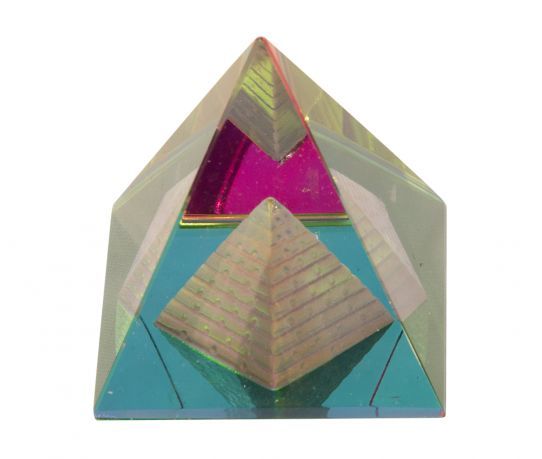We use cookies to make your experience better.
Pyramid in Quartz & "rainbow colors" 3D designed.
- Buy 10 for €2.50 each and save 16%
Quartz is a form of silicon dioxide, SiO2 and is one of the most common minerals on the earth's crust. It represents more than 12% of the volume of the Earth's crust (including in granite, sand). Quartz has two modifications: α-quartz is trigonal, β-quartz (a higher temperature form) is hexagonal. In addition, silicon dioxide is found in many other structures such as α- and β-cristobalite, keatite, tridymite, coesite, stishovite, melanophlogite and lechatelierite. Although quartz consists of silicon dioxide, it is often counted among the tectosilicates. The reason for this is that quartz forms a network of SiO4 tetrahedrons. Hereby each oxygen atom is divided by two silicon atoms. Individual SiO2 molecules only occur with gaseous silica. Quartz can be very pure, as with rock crystal, but often contains impurities. These impurities may consist of ions that are incorporated into the crystal lattice during the growth of the crystal. Quartz crystals can contain between 13 and 15,000 ppm of Al3 +, between 9 and 1400 ppm of Na +, between 3 and 300 ppm of K + and traces of Fe3 +, Ti4 +, P5 +, H + and Li +. The aluminum and iron in combination with ionizing radiation are responsible for the color of a number of quartz varieties. Furthermore, quartz crystals can grow over other minerals, as is the case with rutile quartz. Quartz can form large crystals as well as microscopically small aggregates. The largest quartz crystals are found in Farm Lost in Namibia. Quartz crystals up to 20 meters, and possibly 50 meters, and dolomite crystals up to 2 meters are found here. When quartz is melted, it often forms a glass during rapid cooling because the crystallization process takes a considerable amount of time. Quartz is a piezoelectric material and the vibrations that can be generated in the crystal lattice are used in electronic equipment such as quartz watches and radios. Quartz is formed, among other things, by crystallization during the cooling of a molten silicate mass. It is therefore an important rock-forming mineral in felsian coagulation rocks, such as granite. However, the largest crystals arise due to the influence of hot water on rocks. Here, quartz dissolves in the surrounding rock in the form of ortho silicic acid and precipitates into cavities and cracks when the solution cools. Quartz can also crystallize in geodes by leaching the surrounding rock. Quartz is chemically free inert and dissolves poorly in water under atmospheric conditions. The water solubility at 25 ° C is between 6 and 11 mg / l. This means that quartz hardly dissolves when weathering quartz-bearing rocks. This makes the most common form of quartz sand and sandstone.
| Dimensions | 47mm |
|---|












